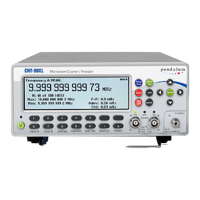Command Reference 8-61
:MEASure :FREQuency :BURSt?
[8 [<expected value>[,<resolution>]] [,<(@«1|2|3|4»)>]]
Burst Carrier Frequency
Measures the carrier frequency of a burst. The burst duration must be less than
50% of the pulse repetition frequency (PRF).
How to measure bursts is described in detail in the Operators Manual.
The counter uses <expected value> and <resolution> to select a Measurement
Time ([:SENSe]:ACQuisition:APERture), see page 8-92, and then sets the
sync delay (:FREQuency:BURSt:SYNC:PERiod) to 1.5 * Measurement Time.
See page 8-95.
Parameters:
<expected value> is the expected carrier frequency,
<resolution> is the required resolution, e.g., 1 gives 1Hz resolution.
<(@«1|2|3|4»)> is the measurement channel:
(@1) means input A
1
(@2) means input B
1
(@3) means input C (RF input, option for CNT-90, standard for CNT-90XL)
(@4) means input E (Rear panel arming input)
If you omit the channel, the instrument measures on input A (@1).
1 The prescaling factor for these channels can be set to 1 or 2 by means of the
command :SENSe:FREQuency:PREScaler:STATe. See page 8-94.
Complies with standards: SCPI 1992.0, confirmed.
:MEASure :FREQuency :POWer [:AC]?CNT-90XL
[8(@3)]
Power C
Measures the power of the signal on input C in dBm or W. Use the command
:FREQ:POW:UNIT DBM|W to select measurement unit.
Parameters:
(@3) is the measurement channel number of the RF input C.
It is redundant in this case, as there is no other RF channel available.

